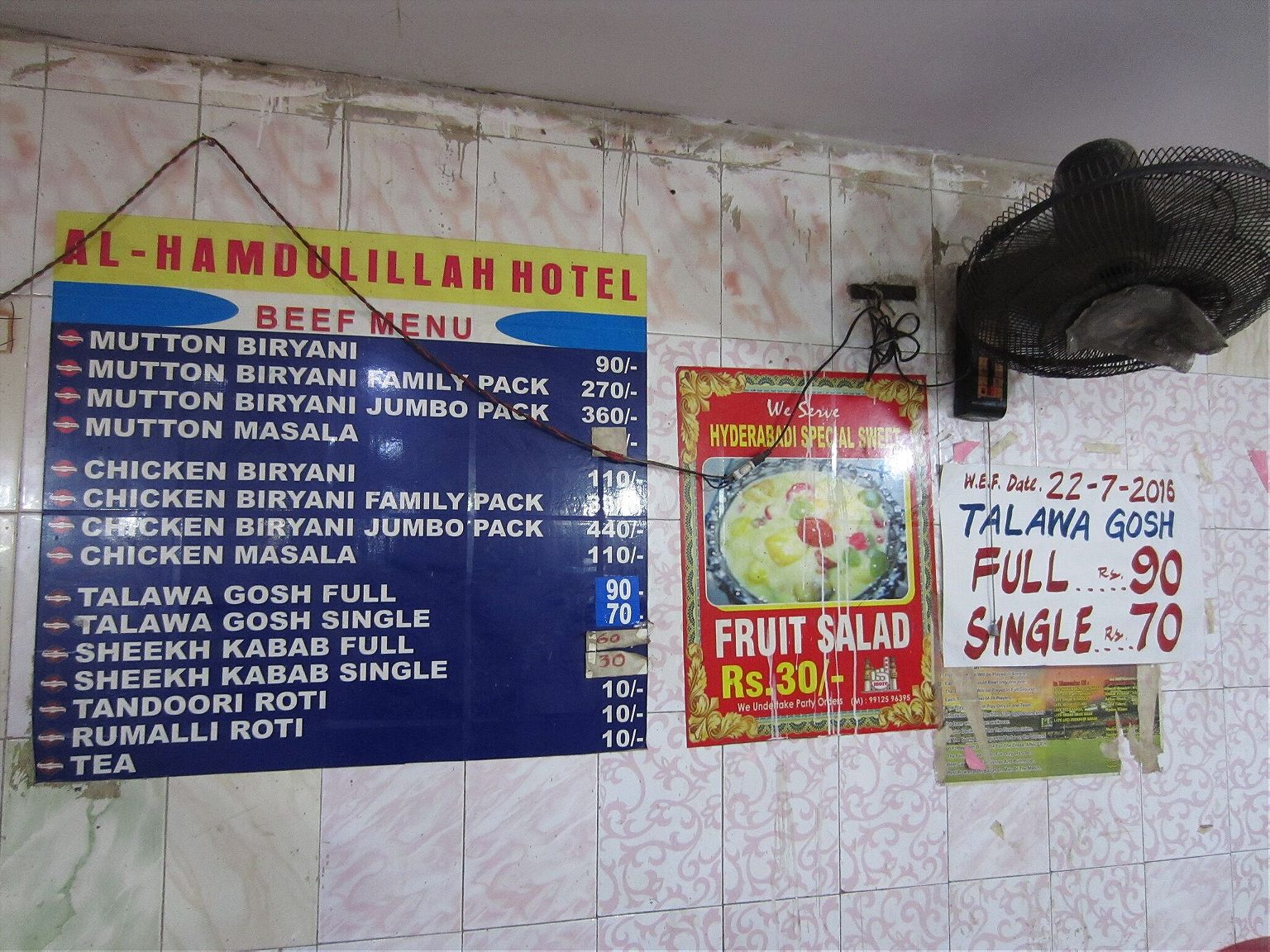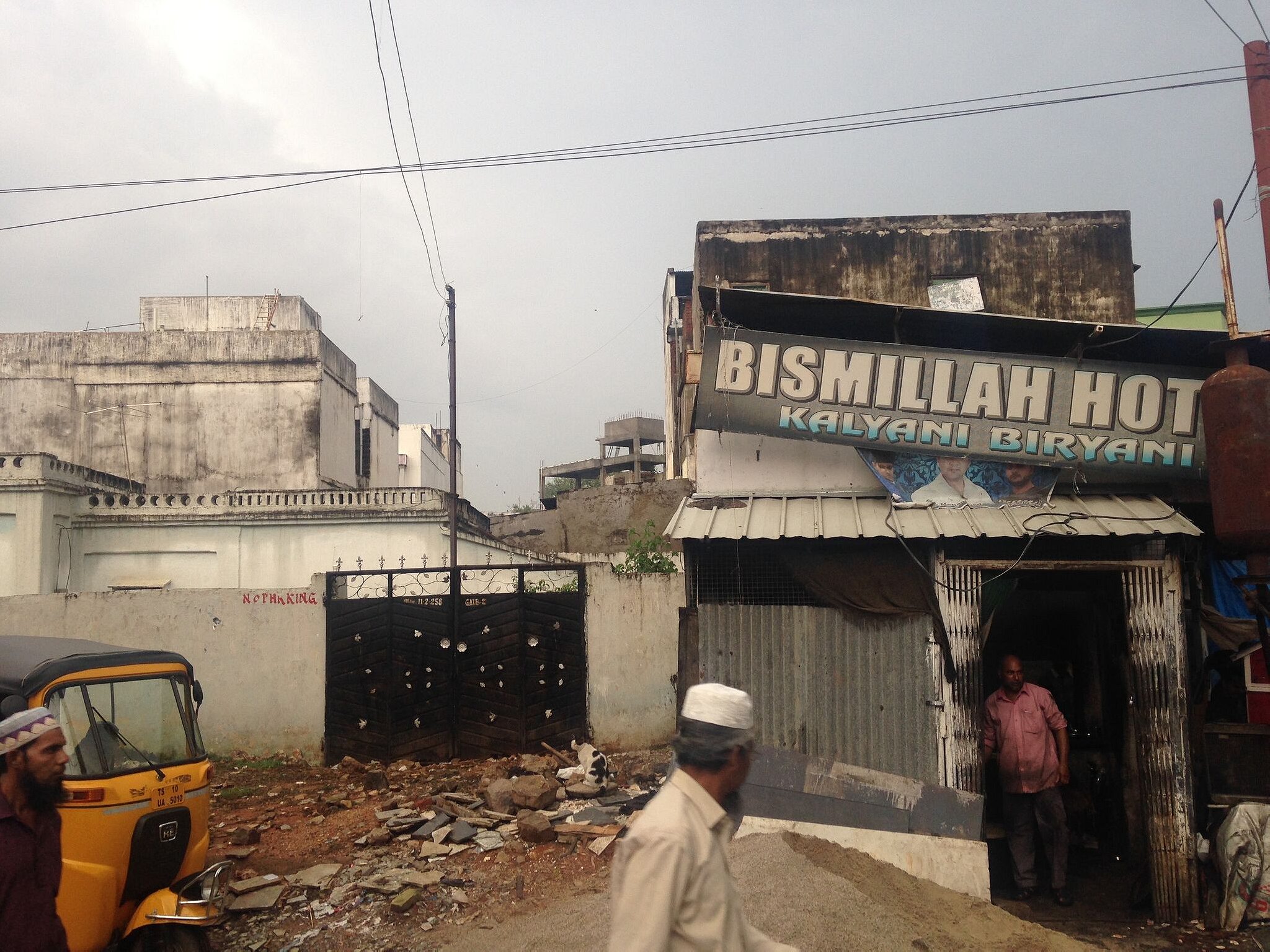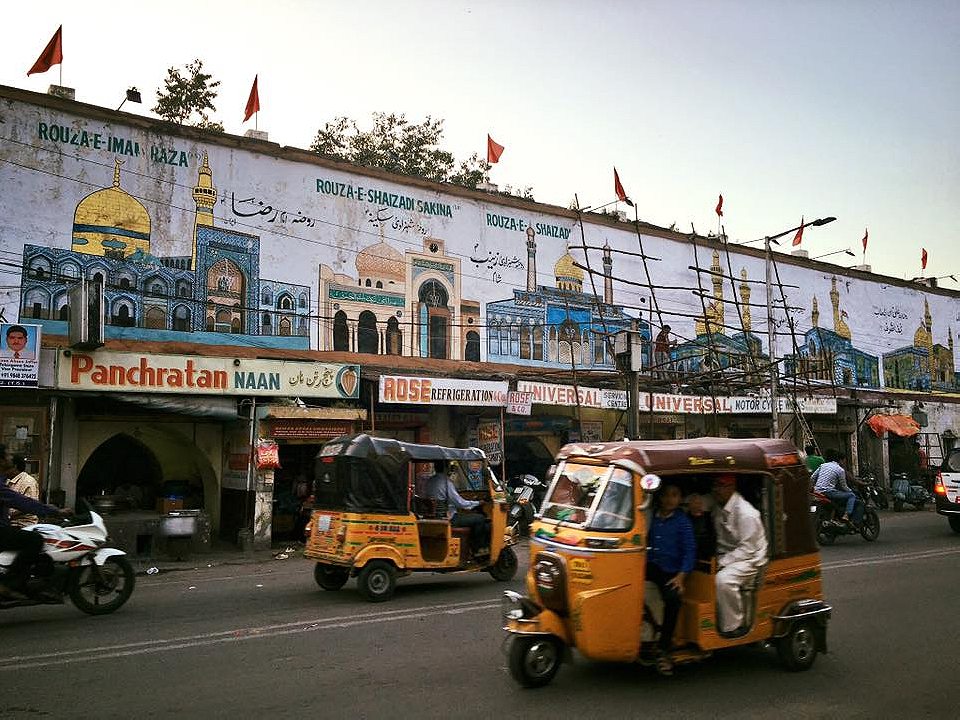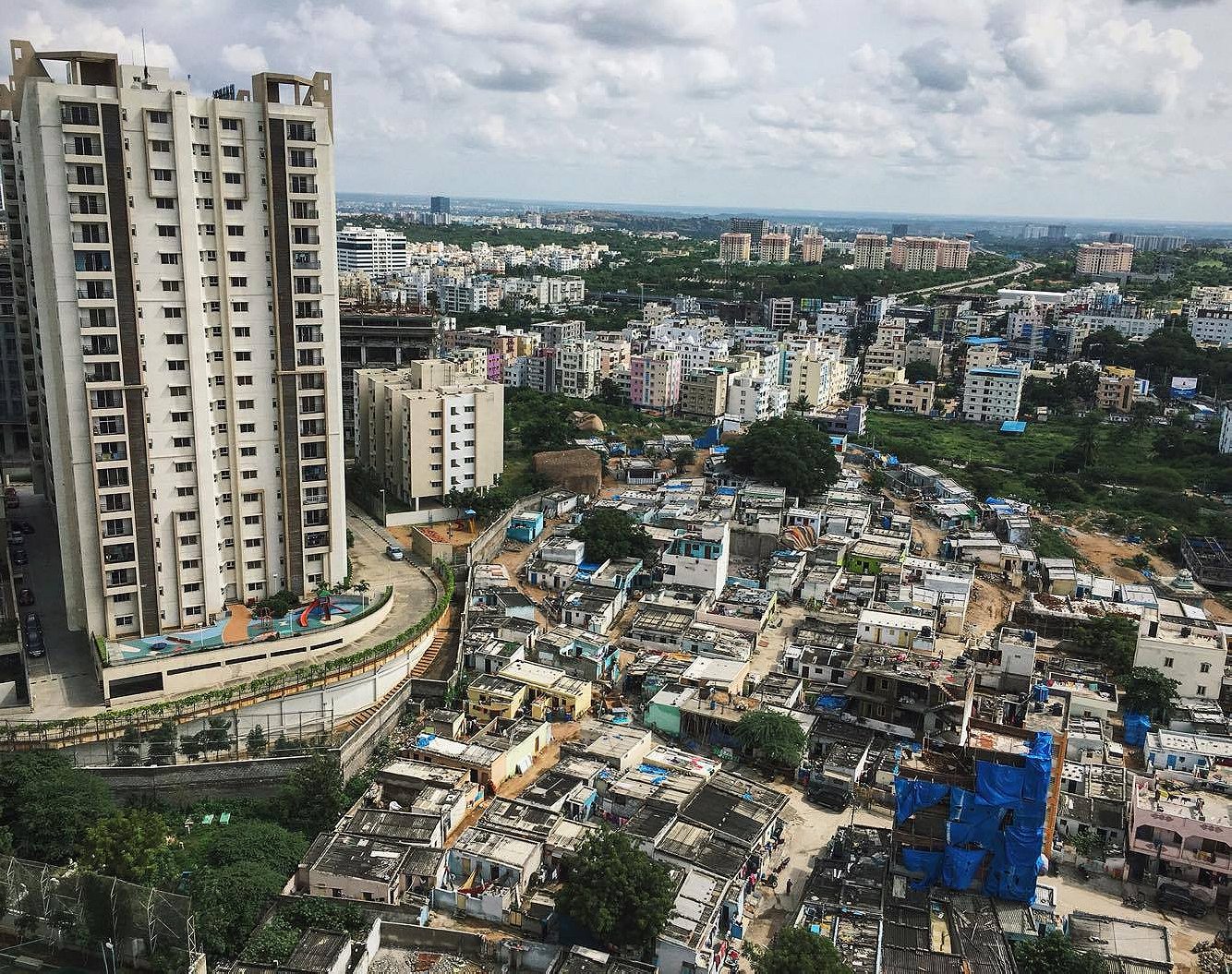In Hyderabad, a cosmopolitan culinary culture fights back against the Hindu nationalist current sweeping the nation.
HYDERABAD, India—
The Alhamdulillah, one of the most famous places to get a bite of red meat in India’s fifth-largest city, is tucked away near one of Hyderabad’s busiest intersections and can be a tricky place to find. The best method it is to head down the alleyway, find your way through the maze of motorcycles and mopeds parked outside, and let the heady scent of beef sizzling in huge cast-iron tavas just outside the entrance guide you right where you want to go.
In a city renowned for its beef, Alhamdulillah stands out. For the last three decades, this restaurant has served up spicy, red meat dishes and a variety of popular Hyderabadi culinary delights to people from all walks of life. The restaurant has developed a reputation as the best place to stop in for Hyderabadi biryani: a mouthwatering rice-and-meat dish delicately spiced with cardamom, cinnamon, cumin, and, of course, several types of chilis. Another local favorite is talava gosht, a dish in which tender morsels of beef are marinated with turmeric, ginger, and garlic and cooked in peanut oil. The gritty, Spartan interior of the restaurant, adorned with bright-white fluorescent lights and hot-pink trim, may not immediately draw in the casual passerby, but the smell of the cooking definitely will.
But Alhamdulillah is also part of a dying breed in India, a restaurant that proudly advertises its beef menu and even fries its dishes right out on the sidewalk in a country increasingly beset by a resurgent wave of Hindu nationalist activism that has made the consumption of beef a charged point of contention.
Indeed, outside of the older and historically Muslim parts of Hyderabad, it is increasingly rare to find beef on the menu. Those places that do serve it up, meanwhile, use euphemisms like kalyani biryani (“special biryani”) to adapt to the new political climate. Despite this, threats of violence against public consumers of beef have recently begun occurring in Hyderabad, raising the possibility that a trend sweeping the country in recent years that has led to dozens of killings could finally reach India’s de facto beef capital.


Food politics are the last thing on the minds of the crowds that flock to the hard, pink-and-white benches that dot Alhamdulillah’s interior. At lunchtime and again in the evenings, the main dining room fills up with crowds of men in a mix of knee-length kurta, pastel-colored shalwar kameez, and flashy collared shirts. Across the hallway, in the family section, the attire is similarly diverse; women in full-face veils sit beside those wearing brightly colored saris and Arab-style hijabs, all crowded in by kids fighting to get their hands on the feasts laid out before them.
At the head of it all is Abdul Sattar Bhai. The eldest son of a working-class family with nine children, Abdul Sattar and a younger brother left their home in Bidar—a small town in Karnataka, just three hours west of Hyderabad—to try their luck in the big city. They arrived in the 1980s armed with just five rupees and their grandfather’s recipes.
“My grandfather was famous for his biryani, and people used to flock to our shop for his special haleem (a buttery cardamom-scented porridge of wheat, beef, and lentils, slow-cooked overnight) during Ramadan,” Abdul Sattar says. “I learned how to make all my dishes from him, including our popular beef biryani.”
Business was brisk for the Sattar brothers, and it wasn’t long before they’d outgrown their little biryani stall and earned enough to build a sprawling, concrete complex filled with small watch shops, tobacco vendors, and mobile-phone dealers.
“We called our first restaurant Bismillah, and our new restaurant is Alhamdulillah,” says Abdul Sattar. To a Muslim, the names make sense: Bismillah means “in the name of God,” an Arabic phrase uttered by the devout before beginning any enterprise or major action, and Alhamdulillah means “thanks be to God,” a reference to Abdul Sattar’s success.

Under the attentive watch of Abdul Sattar, the eating hall is busy with hungry patrons at all times of day. Aside from beef biryani and talava gosht, the restaurant also serves up traditional Hyderabadi favorites like paya ki nihari, lamb trotters in a minty broth topped with fried onions, and beef dalcha, a hearty tamarind-and-lentil stew cooked with beef and bottle-gourd squash. And of course, sweets are never far behind, with authentic Hyderabadi desserts like double ka meetha, a local take on bread pudding in which slices of bread are deep-fried, soaked in a sugary cardamom cream, and topped with saffron and sliced almonds, and qubani ka meetha, dried apricots stewed in a syrup of cinnamon and honey and commonly served with ice cream.
Alhamdulillah’s beef menu attracts people from all communities in Hyderabad, a rarity in a city riven by segregation and a history of conflict between Hindus and Muslims. Abdul Sattar claims that the majority of his patrons are actually Hindus who have standing orders for beef biryani.
Contrary to popular Western conceptions, Hinduism does not insist upon vegetarianism or the worship of cows as a universal norm for its followers. It is only upper-caste Hindus—primarily Brahmins—for whom beef-eating is customarily forbidden. For lower-caste Hindus, who comprise the majority of the religion’s adherents, no proscriptions exist against beef. For Dalit communities, also known in English as “untouchables,” beef is a traditional food integral to their sense of cultural identity. The meat is often sold as a cheap and nutritious alternative to goat, the red meat typically preferred by India’s middle classes.
Surprisingly, India is the world’s second-largest exporter of beef, but ordering a plate of the meat locally is not as simple as you’d think. While it is not illegal to eat beef in India, many states have made it extraordinarily difficult to legally source the meat. Some states, like Punjab and Rajasthan have extremely stringent prohibitions against cow slaughter. Telangana, the state in which Hyderabad is located, forbids the slaughter of cows but permits the slaughter of bulls. In many areas, water buffalo has become a preferable substitute for beef.
Over the past couple decades, Hindu nationalism has grown increasingly influential across India. Political parties like the Bharatiya Janata Party, or BJP, India’s current ruling party, and paramilitary groups like Rashtriya Swayamsevak Sangh, or RSS, have aggressively pushed to make distinctly upper-caste Hindu practices like vegetarianism and cow worship normative for not just Hindus but Indians of all religious backgrounds.


In cities across the country, vigilante “cow protection brigades” or gau rakshaks, have formed with semi-official sanction. These committees are full of zealous young men who patrol the streets in open-air trucks looking to halt the transport of cattle for slaughter. Critics charge that these groups essentially build lynch mobs out of floating rumors. In September 2015, a Hindu mob lynched a Muslim man just miles outside of Delhi, the nation’s capital, on the suspicion that he was storing beef in his fridge. More recently, members of a gau rakshak brutally stripped and flogged a group of Dalit men for allegedly skinning a dead cow in Gujarat, the home state of prime minister and BJP leader Narendra Modi.
Although few in Hyderabad vote for the BJP, the influence of Hindu nationalism is increasing among local Hindus, who form about two-thirds of the city’s population. Gau rakshaks in Hyderabad tend to spontaneously emerge around Muslim holidays like Eid al-Adha, when meat is a central dimension of the festivities.
Shefali Jha, an anthropologist whose work focuses on Hyderabadi political culture, observes that “unlike in other cities, these cow protection groups are not formally organized. They receive the discrete patronage of right-wing politicians but unlike in northern India, none of them have been able to become permanent to date.” But she also notes that Hyderabad has seen a regular, if unsustained, emergence of such groups in the last decade.
ALHAMDULILLAH PROVIDES A SAFE HAVEN FOR BEEF LOVERS
Amid this increasingly tense climate, Alhamdulillah continues to provide a safe haven for beef lovers and fans of traditional Hyderabadi fare. The restaurant is a testament to the resilience of old Hyderabad’s syncretic culture.
The city’s unique culinary tradition is a legacy of the hundreds of years during which it was ruled by the Nizams, a dynasty of Central Asian and Persian lineage that managed to maintain self-rule even after the British colonized most of India in the 19th century. The Nizams developed a rich cuisine that mixed local South Indian Telangana spices with cosmopolitan Persian and Arabic flavors, and beef became a central part of culinary culture.
In 1948, however, newly independent India forcibly annexed Hyderabad to the newly created republic. In the decades that followed, thousands of migrants from the majority-Hindu, Telugu-speaking Andhra coast began moving in, dramatically shifting the demographics of this city that was once half-Muslim, half-Hindu. This also led to a slow marginalization of the Urdu-speaking (and beef-loving) Muslims who comprised a plurality in the city.
Many of the new coastal migrants were shocked to find a city where Urdu—which is similar to Hindi and predominant in much of North India and Pakistan but uncommon in the South—was the lingua franca, while Telugu was limited to Hindus. Over time, the situation began to reverse. Today, only about one-third of the city is Muslim, while the rest are overwhelmingly Telugu-speaking Hindus, along with some North Indian Hindus who have migrated to work in the city’s booming high-tech industry.

Hyderabad, like other major Indian cities, is segregated not only in terms of religion but also caste. In the older, Muslim-majority neighborhoods, beef shops are a dime a dozen. But in the newer parts of the city, they are a rarity. And yet, as anthropologist Jha notes, “this segregation is neither as absolute or as dangerous as in other major Indian metros.” In fact, it has allowed the open sale and advertisement of beef in some parts of the city and enabled the flourishing of restaurants like Alhamdulillah in Muslim-majority neighborhoods. Still, the restriction of these restaurants and shops to particularly Muslim neighborhoods means, as Jha notes, “that beef is still a ‘public secret’ Hyderabad shares with other Indian cities.”
But how long this situation can last is unclear amid the rising influence of Hindu nationalist ideas. At Osmania University—Hyderabad’s oldest and largest public institution of higher education—pressure by Hindu nationalist student groups prevented the school cafeteria from serving beef.
In response, a new and outspoken generation of Dalit and Muslim student leaders fought back. Since 2006, they have organized yearly beef festivals to draw attention to the segregation faced by lower-caste Hindus and Muslims in contemporary India, noting that the stigmatization of their consumption of beef was part of a larger attack on any form of public culture in India that did not fit high-caste Hindu norms. In celebrating beef-eating in this highly public manner, such meat-heavy festivals have showcased the rich and diverse food traditions of Hyderabad and sought to claim public space for marginalized communities.
THEY URINATED ON BEEF DISHES IN FRONT OF HORRIFIED ONLOOKERS
These festivals have been repeatedly attacked by Hindu nationalists, with gangs of right-wing students vandalizing stalls and assaulting organizers. In some cases, they have even urinated on the beef dishes in front of horrified onlookers.
These incidents have pushed leftists in the city to double down on their commitment to supporting restaurants like Alhamdulilah. After activists won a major victory to revoke the suspension of professors who had been under attack by Hindu nationalists after protests earlier this year, the restaurant was the scene of celebrations.
“We all came to Alhamdulillah to celebrate. We ordered many plates of talava ghosht and beef biryani and ate to our hearts content!” Moses Tulasi, a queer filmmaker based in Hyderabad, says.
For his part, Abdul Sattar Bhai is unmoved by the rise of gau rakshaks or the violent anti-beef sentiments of Hindu nationalists. Over a piping hot cup of Irani chai and a saucer of salty Osmania biscuits, he says, “these tensions don’t exist in our restaurant.”
“Hindus and Muslims are like brothers here. There is a lot of love and affection between the communities.” And, with a chuckle, he added: “Even great Hindu priests have dined in my restaurant from time to time. Everyone is welcome here.”
